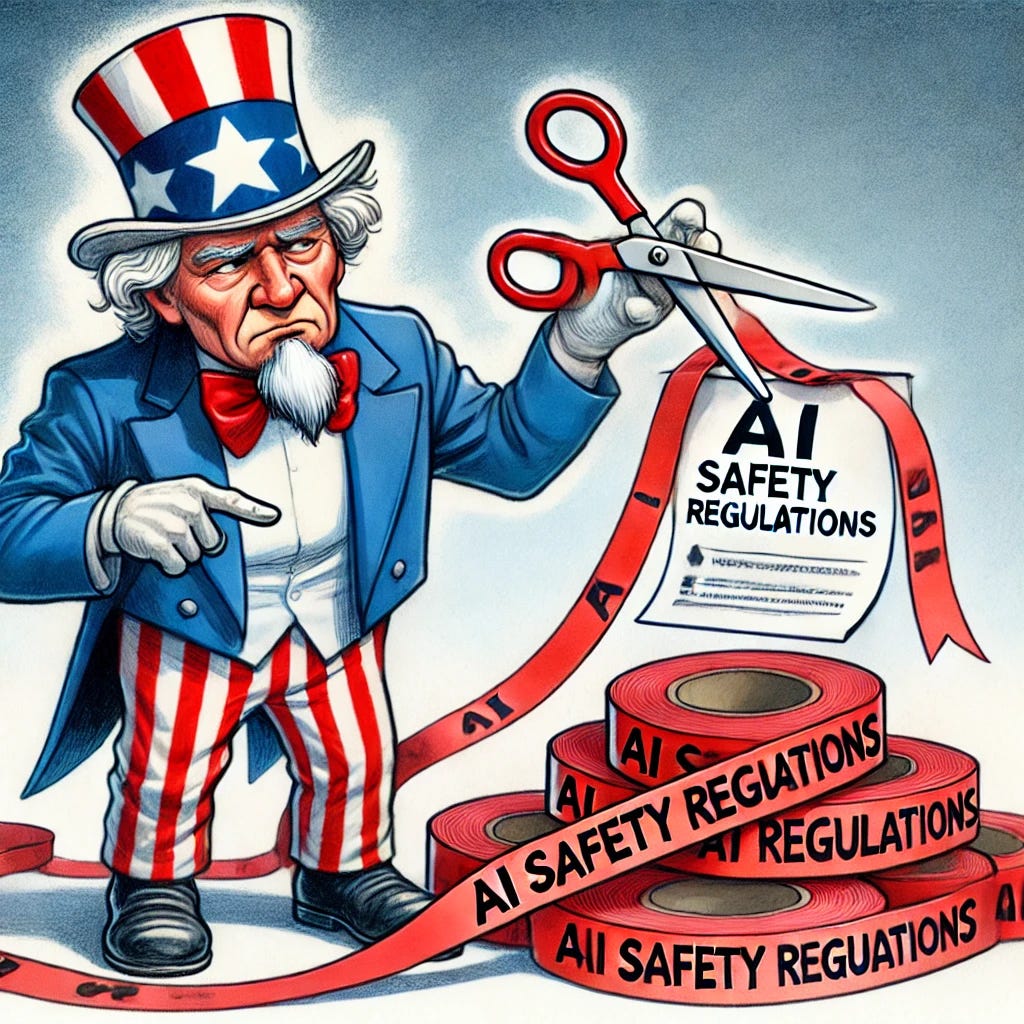Safety Second: What Trump’s AI Policy Shift Means
A guest post from Aaron Spitler
Aaron Spitler is an analyst who specializes in digital technologies, human rights, and democratic governance. The views expressed here are entirely his own. He can be reached at aaron.m.spitler@gmail.com.
The Trump Administration has sought to unleash AI innovation. What could go wrong?
The Trump Administration’s approach to AI represents a sea change. Since taking office in January, the president and his allies have redefined government policy on AI, focusing on accelerating innovation rather than prioritizing safety. The first salvo was rescinding a Biden-era executive order on responsible AI development, which was followed by a new directive stripping away perceived “barriers to American AI innovation.” These actions, along with potential cuts to agencies conducting AI-related research, underline the administration’s eagerness to upturn the status quo.
It is worth grappling with the long-term implications of these substantial policy changes. At home, eliminating AI-related protections may spell trouble for average citizens, from job seekers to benefits claimants. Internationally, the pivot in strategy undercuts cooperation on AI safety at a critical time in the technology’s evolution. These decisions, in the eyes of officials, were made to cement American leadership in AI. The tactics employed by decision-makers run counter to that goal.
Disruption At Home…
There is significant speculation about the benefits AI will bring to American citizens. What is clearer are the harms it has already caused to them. In a blog published by the American Civil Liberties Union (ACLU), the authors underline that AI solutions have already presented myriad issues such as unfairly screening job applicants to unjustly handling benefits requests. Removing the limited number of safeguards currently in place will exacerbate these known problems, affecting Americans from all walks of life.
Supercharging AI deployment without guardrails will also supercharge the well-documented harms that are already happening. That means more people are being denied jobs because AI ranked them lower than an equally qualified person. More people are also having their benefits cut or flagged for fraud based on erroneous or unfair AI determinations. We’ve also seen numerous instances where automated systems deployed in government contexts without appropriate guardrails lead to costly, inaccurate, and inefficient outcomes for everyone-- achieving the direct opposite of the oft-stated goal of adopting AI in the first place.
In the absence of leadership from Washington, it will be up to state governments to defend citizens’ interests. Colorado legislators, for instance, have taken this challenge head-on, as a 2024 law now regulates the use of AI in high-risk activities, like reviewing job applications and approving loan requests. AI-focused policymakers across the country may look to their statehouse colleagues for guidance moving forward, especially as federal officials continue to downplay AI bias issues.
… And Abroad
Overseas, the United States’ move away from policy that centers AI safety has not gone unnoticed. For instance, the European Union and its risk-based model to AI regulation now finds itself diametrically opposed to the US’ more laissez-faire approach. A piece from The Conversation outlined how this disconnect will lead to increased friction between the two powers, especially as certain leaders in Washington have already taken aim at Brussels’ existing digital strategy.
The geopolitics of digital regulation may push the EU towards an under-enforcement of its own digital rules so that it can continue to rely on US tech companies and avoid tariffs. The recent US executive orders may cause a chilling effect on the enforcement of the DMA [Digital Markets Act] and the DSA [Digital Services Act], or a potential lax application of the EU AI Act that required developers of AI systems to respect a series of standards for their products to be lawfully marketed in the EU. Worryingly, some weeks ago the EU withdrew the proposed EU directive on AI liability, which introduced rules on how people could claim compensation for damages caused by AI systems.
While some in Europe are standing their ground, others have been prompted to reevaluate their approaches. The United Kingdom, as an example, has refocused its attention on AI security after previously positioning itself as a leader in AI safety, potentially in response to strongarming from across the pond. The Trump Administration’s aggressive methods highlight their dogged determination to reshape tech geopolitics. Whether they will also fundamentally alter transatlantic cooperation on AI regulation remains to be seen.
Striking A Balance?
Just months into his tenure, the president has made clear that norms centered on innovation and competition will drive his strategy on AI. This not only means that concerns about how AI can produce biased and inequitable outcomes will be minimized. It also will generate tension with traditional allies, such as those in the EU and UK, who formerly strove to find common ground on AI issues.
However, this scenario is not set in stone. The executive order mandating cuts to established regulations also called for the drafting of an AI action plan shaped by public inputs. Stakeholders in this space must seize the opportunity to draw awareness on the urgent need for addressing documented harms and prioritizing global cooperation. American leadership in this ever-changing field depends on it.



